Influencer Product Gifting: How to Run an Effective Gifting Campaign
Influencer gifting campaigns can build awareness and help brands get influencer content at scale. Here’s how to send products to influencers with a...
Social media collaborations with creators can boost your brand awareness ASAP. Below we break down benefits, examples and steps for planning a collab.


“Hey, we love your content! Interested in a collaboration?
You’ve probably seen fellow brands post similar comments across Instagram and TikTok, right?
The rise of consumer-to-consumer marketing means more people are turning to social media for product recommendations and research.
Heck, 82% of consumers claim they’ve made or considered a purchase based on what friends, family and influencers post.
That’s why brands are turning to creators and influencers to spread the word. After all, the benefits of social media collaborations between brands and creators are well-documented. This includes:
Curious about scaling social media collaborations for your brand? This post breaks down the basics.
Skip to Section 👇4 Examples of Social Media Collaborations in Action Breaking Down the Benefits of Social Media Collaborations |
There is no one-size-fits-all approach to collaborating with creators and influencers.
Are you focused on reaching new audiences? Sign-ups and sales? Hyping a product launch?
All of the above?
Either way, it’s crucial to understand how collaborations work and actually tie back to your goals.
First thing’s first: let’s look at the most common types of social media collaboration opportunities. We’ll also highlight examples of how brands are turning their collabs into meaningful customer engagement.
Sponsored content is a type of media created by a third party on behalf of a brand to promote a product. Sponsored content is seen frequently on social media when a brand compensates a creator in exchange for posting about a product on their profiles. Most creators receive compensation for their posts through direct payment or gifted products.
And despite popular belief, sponsored content and traditional ads are not the same.
That’s because sponsored content is produced by a creator rather than the brand itself. Sure, brands will provide input and instructions to support the creator.
But the biggest upside of sponsored content is that creators can let their personalities, values and voices shine through their posts.
.png?width=350&name=image%20(1).png)
Source: @taylordini
Sponsored content works because of authenticity. Consumers respond better to unpolished and unfiltered content versus ads that feel like commercials. Fact: sponsored social videos are 62% more likely to generate a positive viewer reaction versus “traditional” ads.
Translation? When ads feel human, they don’t feel like ads at all.
On that note, humor is a proven way to make sponsored content work. This TikTok collaboration between Becca Bastos @actressbecc and Snapple is a great example:
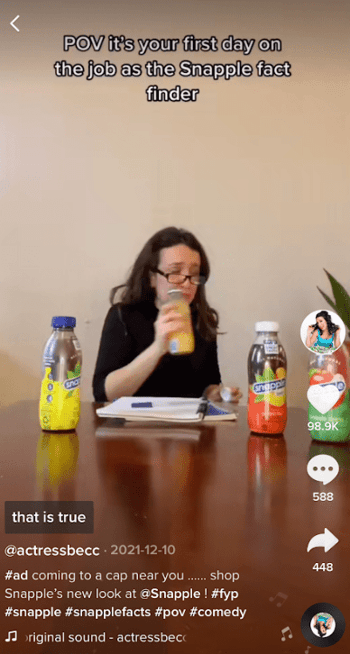
Source: @actressbecc
Rather than posting a “safe” sponsored post for Snapple, Becca incorporated Snapple into one of her comedy skits. Becca made a conscious effort for her sponsored post to feel just like the humor-driven content she posts on her own feed.
And given the level of engagement and positive responses from commenters, it’s clear that her creativity paid off (like, literally).
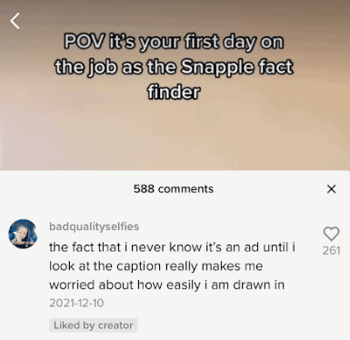
Source: @actressbecc
This is one of our favorite social media collaboration examples because the creator's personality is just so front and center.
Keep in mind that most consumers know when they’re watching an ad or looking at a sponsored post. Given the popularity of influencer marketing, sponsored content is more widespread than ever.
Thing is, talented creators will put effort into their posts so they don’t feel like generic ads. Doing so helps the creator delight their existing audience and creates a more impactful marketing asset for your brand.
Note: sponsored content must be identified and acknowledged through captions and hashtags (#ad, #gifted or #sponsored). Be sure to include this in your influencer brief when requesting sponsored content so creators remember to add it.
Investing in a social media collaboration doesn’t have to be a total time-sink.
Encouraging your followers and customers to post user-generated content (UGC) is as simple as, well, asking.
For example, many brands promote a branded hashtag on their Instagram or TikTok bio. Customers then publish content to the tag that shows off their latest purchases or shouts out the brand. This is a sort of passive way to generate consistent, ongoing engagement and collaboration opportunities.
Aside from forming a more personal connection with fans, branded hashtags are a way to source authentic UGC that you can repost and repurpose. This is one of the biggest benefits of social media collaborations that brands shouldn't ignore.
For example, HydroFlask promotes their #HeyLetsGo tag throughout their Instagram and website. 30,000+ customers have already shared product photos to the tag. In turn, HydroFlask republishes the best photos to their feed.
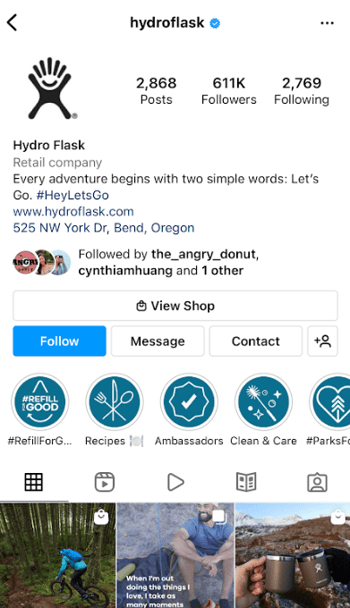
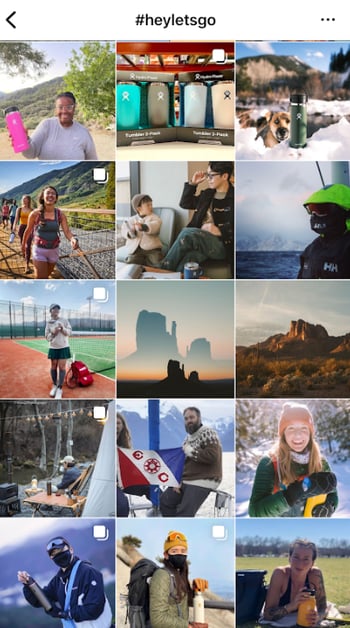
Source: @hydroflask
Hashtag campaigns like this are probably the most “hands-off” examples of a social media collaboration (beyond asking for permission for republishing). That said, publishing UGC is a prime way to make an impression on your audience and uncover your biggest brand advocates.
Another upside of hashtag campaigns is the opportunity to repurpose UGC across all of your brand’s channels (hint: not just social media marketing). For example, HydroFlask sources customer photos from Instagram to add onto their product pages. This showcases what their products look like “in the wild” which is great for boosting conversions.
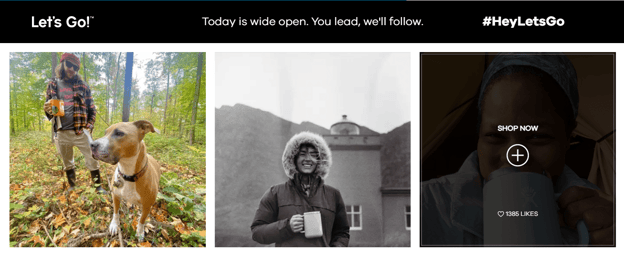
Source: HydroFlask
But keep in mind that hashtags like this don’t take off overnight! If you decide to go the hashtag route for a UGC campaign, know that frequent publishing, promotion and patience are all required.
Arguably the most involved form of social media collaboration, brand ambassador programs are booming in industries like beauty and fashion.
Think of brand ambassadors as your die-hard fans and biggest cheerleaders. You know, the customers that would gush about your brand without getting paid to do so.
Through an ambassador program, you can encourage these types of customers and advocates to promote your brand long-term in exchange for compensation and other perks. Unlike sponsored content, collaborating with brand ambassadors usually represents an ongoing, long-term relationship.
Brands like Pura Vida are known for their extensive ambassador program. Once approved, ambassadors receive a promo code to share with their followers. Every time a follower makes a Pura Vida purchase with that specific promo code, the ambassador earns a commission.
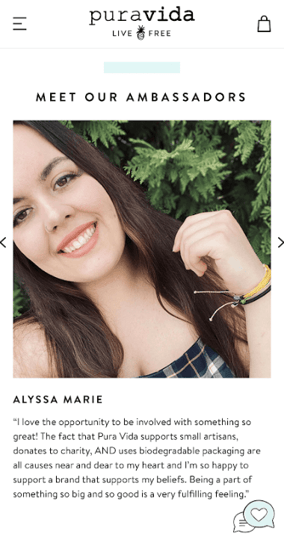
Source: Pura Vida
Aside from commission, ambassadors also earn perks like free products, a sneak peek at new launches and access to giveaways. Note that many brand ambassador programs offer exclusive discounts or free products instead of direct financial compensation.
Dedicated brand ambassador programs require a lot of legwork, though. This is especially true if you’re trying to pitch and hire them yourself.
Consider that the stakes are obviously higher when you have people acting as an extension of your brand. The process of vetting, compensating and managing relationships with ambassadors is no joke. That said, you’re almost always guaranteed high effort, on-brand content. There’s definitely a trade-off.
If you’re looking to get creators about your products, gifting products can make it happen (on a small scale).
The concept is simple — you hook creators up with freebies and samples in exchange for social shout-outs and reviews. “Free” is a powerful motivator for creators and influencers of all shapes and sizes.
Gifted products are particularly effective for winning over up-and-coming influencers (aka micro-influencers). These creators are eager to work with brands and likewise will go the extra mile to make their promotions pop. It’s a win-win situation.
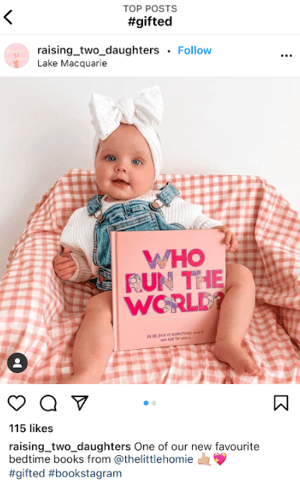
Source: @raising_two_daughters
This type of collab serves as a simple, DIY way to work with creators. In other words, you don’t need to worry about drawing up lengthy contracts or committing to a full-fledged partnership.
In situations where creators don’t love your product, the stakes are pretty low. Granted you’re courteous and positive in your outreach, there’s not much that can really go “wrong.” You’re basically out of whatever free product you shipped, not to mention your time. And you may get some valuable product feedback in return if you follow up.
The drawback? Gifting products DIY is a massive time-sink. The time required just to research and conduct personalized outreach with creators is overwhelming. Without an influence platform to streamline the process, you're looking for 70+ hours plus to possibly earn a handful of posts.
If you’re on the fence about collabs, we get it.
Building meaningful relationships with creators and influencers doesn’t happen by accident. The process isn’t as simple as someone making a post and sending sales your way.
However, collabs should be a top priority for brands that want to give themselves a competitive advantage and scale faster. Below are some social media collaboration stats that highlight exactly why:
This is why brands are turning to sponsored social media posts and partnerships over paid ads (or finding opportunities to combine the two to improve ads ROI). Couple this with upcoming ad targeting changes and the popularity of influencers is only going to grow.
Another added bonus of influencer collaborations is that you can stretch your promotional budget further. Translation? You can enjoy the benefits of social media collaborations long-term.
Whereas leads and sales ultimately taper off when your ads do, creator partnerships provide you UGC and social proof that you can use, well, forever.
Needless to say, you’ve got options when it comes to collabs!
There is no “right” answer here. Different types of social media collaborations have their pros and cons. That said, here are some considerations to help you hone in on a collab that makes perfect sense for your brand:
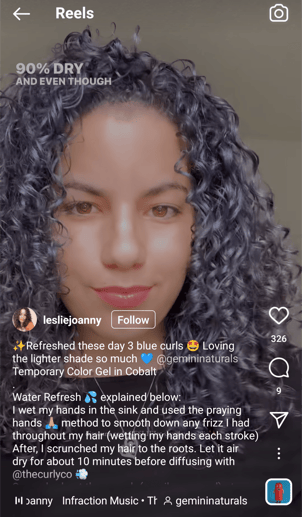
Source: @lesliejoanny
To say that we’ve run our fair share of collabs here at Statusphere would be an understatement.
And trust us: we’ve seen it all!
To wrap things up, we’ll spill the tea of what makes or breaks a brand-creator partnership:
If you want to write a proposal that stands out, check out our influencer outreach templates that actually earn responses.

There’s no denying the work that goes into any given collaboration campaign.
That said, they’re well worth the investment. We’ve seen firsthand how word-of-mouth marketing can drive massive engagement (like 1.6 million people reached in 90 days).
If you need a scalable way to get more social media influencer content, Statusphere can help.
Our micro-influencer software matches brands with vetted influencers from our creator community using 250+ first-party data points. Unlike other platforms, we help brands earn a high volume of guaranteed content long-term.

Statusphere also eliminates the most time-consuming pieces of working with influencers in-house thanks to our advanced matchmaking and fulfillment technology. We’ve already generated 75,000+ pieces of content for 400+ consumer brands.
Want to see how our platform works? Get in touch with one of our experts to learn how we can optimize your brand’s influencer marketing with guaranteed content at scale.
This article was first published in May 2022. It was last updated October 22, 2022.
Influencer gifting campaigns can build awareness and help brands get influencer content at scale. Here’s how to send products to influencers with a...
Want to ramp up your brand’s influencer seeding efforts? This post can help! Here are eight influencer seeding strategies and tips for earning...
Influencer gifting and paid collaborations seem identical at a glance. Spoilers: they’re not! This post explains the difference and tips for brands...
Be the first to know about the latest tools, trends and strategies in influencer marketing for brands.